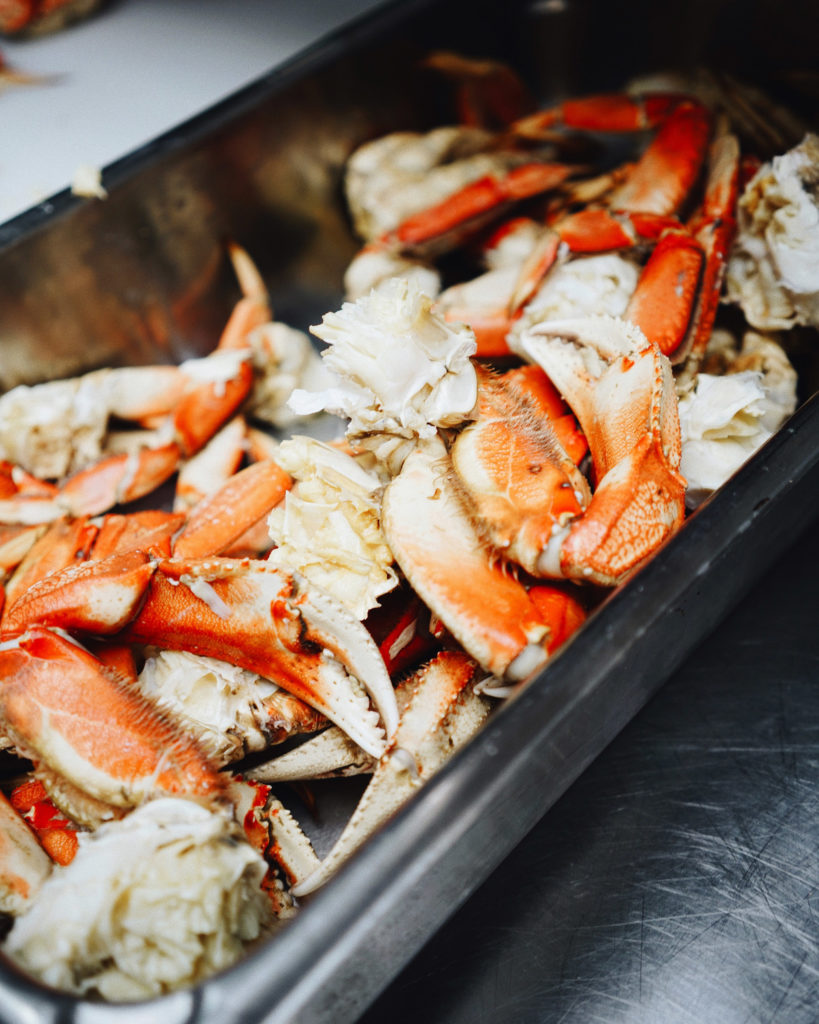
Despite the dreary weather this time of year, a certain population of enthusiasts sure are feeling “crabulous.” It’s Dungeness time. Always an exciting time of year, this fervor is buoyed by the fact that winter recreational crabbing is open daily now through December 31 in several spots in the Northwest.
Get your traps ready and set sail: Current open areas include the Strait of Juan de Fuca east of the Bonilla-Tatoosh line to the Partridge Point-Point Wilson line (Marine Areas 4, 5, and 6); the San Juan Islands (Marine Area 7); the eastern side of Whidbey Island (Marine Areas 8-1 and 8-2); northern Puget Sound/Admiralty Inlet (Marine Area 9); and Hood Canal north of a line projected true east from Ayock Point (Marine Area 12).
All the crab openings set by the Washington Department of Fish and Wildlife (WDFW) shellfish managers are based on sport crab harvest estimates that use catch record card information from the summer season and the winter season expectations. Therefore, central and southcentral Puget Sound (Areas 10 and 11) will remain closed due to uncertainties related to the amount estimated to be taken in the summer recreational fishery. Managers will re-evaluate the harvest estimates from Marine Areas 10 and 11 after the catch record card reporting period closes to determine if enough quota remains to allow a winter fishery. Hood Canal (Area 12) south of a line projected true east from Ayock Point and southern Puget Sound (Area 13) will remain closed for the remainder of 2022 due to a low Dungeness crab population.
One important note: be sure to fill out your catch cards to help the state manage the crab fishery in the seasons to come. “It is important that crabbers return their catch record cards at the end of the season in order to help us better understand and manage this fishery, said Don Velasquez, a WDFW shellfish manager. “Only about 50 percent of crabbers record their catch at the end of the season, and this information is critical for setting future seasons. We need those catch record cards returned or reported online, whether or not you caught any crab, to determine levels of sustainable catch and set harvest seasons.”
Know Before You Go:
- The daily limit per person in all open marine areas is five for Dungeness crabs, six for red rock crabs, and six for Tanner crabs. All Dungeness crab retained must be recorded on a winter catch record card. Be sure to fill out your crab catch cards immediately after landing crabs and prior to re-setting your traps.
- Dungeness crab must measure at least 6 ¼ inches at the widest point of the shell just in front of the rearmost point or tips. The most accurate way to measure a crab is a plastic caliper crab gauge available at most sporting goods stores. Red rock crab must measure at least 5 inches.
- Pots or traps are the most popular way to catch crabs and are usually set from 10 to 60 feet deep but sometimes up to 100 feet or more. Ring nets require more frequent checking as bait can be taken away by crabs, unlike pots that trap crab via the one-way entry points.
- Depending on the crab trap and water conditions such as strong tidal influences or currents, it is wise to add additional weight (10 to 20 pounds) to keep it from drifting away and stable on the sea floor. Some crabbers will put a brick inside the cage, while others like to lash rebar or fishing weights (try to avoid lead weights) to the bottom of the trap.
- For the mainline to the crab pot, many opt for the inexpensive yellow quarter-inch poly line or leaded line. The yellow line floats and can be an issue especially in areas where there’s a lot of boat traffic. These lines can get tangled in a boat’s prop or cut off so be sure to clip a weight to the line to pull it under the surface. Leaded lines are more expensive, but they sink properly and are easy to coil after you get it in the boat.
- Be sure your crab pots are clearly marked on the surface of the water and visible with a half red, half white crab buoy. As part of the regulations, you must write your name and address on the buoy. To make your buoy stand out from the others be sure to attach a unique brightly colored flag or shiny mylar colored ribbons that will help you easily locate your pot.
- The best bait options are salmon or fish carcasses and heads as well as squid, clams, chicken, or turkey parts. It is always good to add store-bought liquid attractants to create a scent line to lure crabs to the traps.
- Wading shorelines with a dip-net during slack tides is another fun way to catch crab. Just be sure to bring mesh bag to carry your bounty.
- Before making plans, go to the WDFW website for regulations and other rules at: wdfw.wa.gov/fishing/shellfishing-regulations/crab.
Best of luck and I’ll see you on the water very soon!